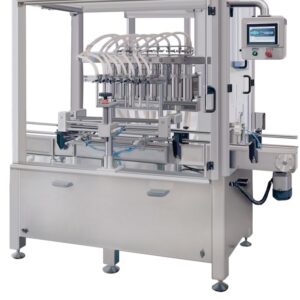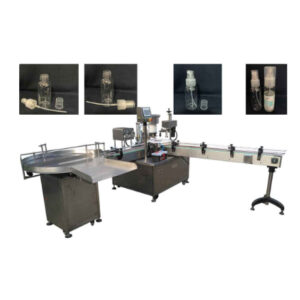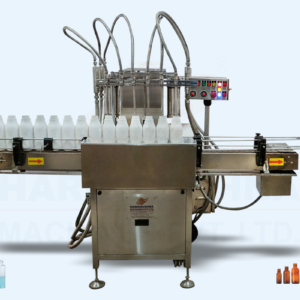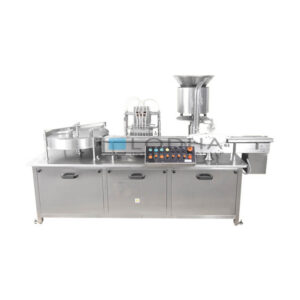Description
| Specification | Details |
|---|---|
| Machine Type | Automatic Oil Filling Machine |
| Capacity | 1000 – 5000 bottles per hour (adjustable) |
| Filling Volume Range | 100ml – 5 liters (customizable) |
| Accuracy | ± 0.5% |
| Power Supply | 220V/50Hz or 380V/60Hz (customizable) |
| Power Consumption | 3 kW |
| Air Pressure | 0.4 – 0.6 MPa |
| Material | Stainless Steel 304 |
| Control System | PLC Control System |
| Filling Nozzles | 4 (customizable) |
| Conveyor System | Variable Speed Conveyor Belt |
| Bottle Type | PET, Glass, or HDPE Bottles |
| Dimensions (LWH) | 2500mm × 1200mm × 1800mm |
| Weight | 800 kg |
| Features | CIP System, Bottle Detection System, |
| Touch Screen Interface, Automatic Stop | |
| Function for Overfilling, | |
| Diving Nozzle for Foam Control | |
| Certifications | CE Certified |
In the contemporary world, where effectiveness and exactness are key, companies are continually looking for new ways of streamlining their processes. One such innovation that has greatly changed the packaging sector is the oil-filling machine. These units play a crucial role in accurately filling different types of oils into bottles, increasing productivity, minimizing waste, and maintaining product quality. This all-around piece comprehensively addresses the kinds, working procedures, applications purposes, benefits, and future trends of oil filling machines.
Types of Oil Filling Machines
Different types of oil-filling machines exist to meet specific production requirements and packaging formats. There are majorly four main types of these machines:
Overflow Filling Machines: Overflow filling machines are often used in cases where there products being filled have thin to medium viscosity like cooking oil, and vegetable oil among others. Such a machine has a nozzle that is put on top of the bottle opening creating a seal and then allowing excess liquid to overflow back into the supply tank hence accurate levels of fill.
Piston Filling Machines: Piston filling machines are suitable for high-viscosity liquids such as motor oils, syrups, and essential oils. They employ a piston system to measure out and dispense an amount of oil desired into containers with great accuracy. They exhibit high precision making them suitable for both small-scale and large-scale output.
Gravity-Filling Machines: Gravity-filling machines work by utilizing gravity force to fill up liquid containers. They can be employed in industries dealing with low-viscosity oils as they typically fit well in industries such as food processing & beverages; pharmaceuticals; cosmetics etcetera. In design they are simple but quite accurate i.e., speed is crucial.
Net Weight Filling Machines: Net weight filling machines displace products by measuring their weight rather than their volume when they fill containers as in the case above now therefore also relieving individuals from labor-intensive manual operations. These machines are constructed in such a way that they can measure the weight of a container before filling as well as after filling, thereby ensuring accurate levels of fill. They are used extensively in sectors where precise product weight measurement is required; for example, in the automotive and chemicals industries.
Volumetric Filling Machines: Volumetric filling machines use volumetric measurements to dispense pre-determined amounts of liquids into containers. They are versatile enough to handle different oil viscosity ranges and various container sizes. Volumetric filling machines find wide application in sectors like cosmetics, pharmaceuticals, and household chemicals.
Working Process of Oil Filling Machines
The process of working with oil-filling machines varies depending on the type of machine as well as the peculiarities of design. But despite this fact, basic principles are similar for all types. Here is a general overview of what happens when using these types of equipment:
Container Placement: The empty bottles are placed on a conveyor or filling platform ready for oiling.
Container Indexing: Containers are indexed or moved into place for filling. This ensures that each bottle is positioned correctly below the nozzle or nozzles that have been fitted on it.
Filling Operation: After positioning the containers, the actual filling process takes place by pouring oil into them. Depending on which kind the machine belongs to, either gravity force, piston mechanism, overflow one net weight one, or volumetric method can be engaged.
Level Control: During the oil filling process, sensors or other devices are used to guarantee that the desired quantity of oil is filled in all the containers. This ensures uniformity of product and conformity to quality standards by regulating overfilling and underfilling.
Container Capping or Sealing: After filling, containers are caped or sealed to prevent any leakage and ensure the integrity of the products. Sometimes this is part of the machine for filling oil while at times it is done using a different sealing machine.
Labelling and Packaging: Following the filling and sealing processes, containers may be subjected to labeling and packaging procedures before they can be distributed.
Cleaning and Maintenance: Regular cleaning and maintenance keep the oil-filling machine in good condition so that it functions optimally for a long. It may necessitate washing out with judicious application of cleansing agents, examining worn-out parts for replacement, lubrication of movable parts, etc.
Applications of Oil Filling Machines
Due to their versatility, efficiency, and accuracy, these machines are widely used across various industries. Some common applications include:
Food & Beverage Industry: Edible oils, cooking oils, and salad dressings among other food-grade oils have been put into bottles, jars as well as containers using oil-filling machines.
Pharmaceutical Industry: Medicinal oils like those used in syrups as well as liquid nutritional supplements can be filled into bottles/vials/containers using oil-filling machines in the pharmaceutical industry.
Cosmetics Industry: Filling essential oils including beauty oils lotions serums is one way in which an oil filling becomes a very handy tool in the cosmetics industry since these can be sold on a retail basis to consumers either from superstores or pharmacies when packaged inside bottles/tubes/containers respectively.
Automotive Industry: Motor oils, lubricants along hydraulic fluids are some examples that can be mentioned when referring to what the automotive industry uses these kinds of machines for; they come in different sizes and are used for various vehicles or machines.
Chemical Industry: Industrial oils, lubricants, solvent wells, and specialty chemicals are some of the products in the chemical industry that may require an oil-filling machine to fill them into drums, barrels, and bulk containers.
Household and Personal Care Products: For instance, the commonly used liquid detergents, cleaning oils, or hair oil can be packaged in bottles/pouches/containers through the employment of oil-filling machines.
Agricultural Industry: In the agriculture field, oil-filling machines find their application when it comes to filling agricultural oils including; pesticides and herbicides among others which will later be distributed or applied on farmlands respectively.
Functions of Oil Filling Machines
Oil filling machines are built to perform different functions that help in efficient and accurate filling operations. The three major functions of oil-filling machines include:
Precision filling: The role of these oil filling machines is to deliver oil in containers with consistency and accuracy to ensure the levels of fillings are on point.
Speed and efficiency: They have speed mechanisms that enable factories to meet the needed production targets within stipulated time limits.
Versatility: Different types of oils and various sizes of containers can be carried out by an oil filling machine, thereby making it suitable for different purposes or production requirements.
Automation An array of automated: systems that can incorporate a touch screen interface, programmable logic control (PLC), or a gear-powered motor has been incorporated into most modern-day oil filing machinery making them require less labor and hence more productive.
Quality Control: In-built sensors, level controls, and camera inspection systems on these packaging lines guarantee full quality compliance for products being filled into containers either by weight or volume.
Flexibility: These machines have versatile characteristics as they can be adapted to fit the specific needs of any manufacturer thus enabling them to use them flexibly in their production setup according to their mode of packaging goods etc.
Minimization Waste: Filling machines reduce wastage through accurate measurement and dispensing processes.
Advantages of Oil Filling Machines
The usage of oil-filling machines benefits manufacturers across different sectors. Some notable benefits include:
Increased Productivity: The higher efficiency rates brought about by these fillers mean that there is more productivity within certain timelines than was possible before
Cost Reductions: There is always reduced wastage when using these fillers during production, which leads to lower costs associated with running the equipment due to minimized spillages and overfills at the same time resulting in improved profitability overall.
Better Product Quality: By ensuring uniform product amounts are transported into each container filled this way brand recognition among customers will improve hence enhancing customer satisfaction and overall product quality.
Compliance with Regulations: In line with the industry requirements concerning product filling and packaging, oil-filling machines are used by manufacturers to comply with such standards.
Frequently Asked Questions
What is meant by an Oil Filling Machine?
An oil filling machine is a specialized industrial equipment used for placing exactly measured quantities of various types of oils including edible lubricants and essential oils among many others into containers. They also ensure accurate measurement during packing processes for liquids.
What types of Oil Filling Machines exist?
Examples of oil-filling machines are piston fillers, rotary fillers, gravity fillers, and volumetric fillers. Each type has its features and benefits that can be matched to different production needs and packaging requirements.
How does an Oil Filling Machine function?
The functioning principle for the oil filing machine varies with the kind of machine being used. Generally, though these will involve pumps, valves, and sensors in controlling the flow of oil into containers. This also entails container positioning as well as capping, sealing, and filling processes among others.
What are some examples of industries where there is use of Oil Filling Machines?
The food & beverage industry, pharmaceutical firms, and cosmetic manufacturing companies within global markets that include automotive or chemical sectors rely on oil-filling machines to package content in bottles, jars, cans, pouches, or other types of containers.
What do Oil Filling Machines do?
Essentially they accurately measure and dispense liquid products into containers at a constant rate. Depending on the configuration they have they may also be involved in container sterilization; cap placement; label application etc.
What are the advantages of using an Oil Filling Machine?
Using oil-filling machines brings about increased efficiency as well as minimized wastage in terms of goods produced which further leads to improved accuracy resulting in better quality products and high output volumes. In addition to this such machinery ensures easy compliance with regulatory standards thereby simplifying packaging endeavors.
Are Oil Filling Machines advisable for small-scale manufacturing?
Indeed, there are different sizes and configurations of Oil Filling Machines to suit small-scale production. Those designed with a compact and versatile model are suitable for start-ups, small businesses, and laboratories.
Can Oil Filling Machines handle different types of oils?
Yes, wide varieties of oils including viscous and non-viscous liquids can be handled by oil-filling machines. They can also come with compatible materials and components that make them compatible with specific types of oil.
What are the maintenance requirements for Oil Filling Machines?
Cleaning regularly lubricating moving parts, inspecting seals and valves as well and having measurement systems calibrated are the usual maintenance requirements in oil-filling machines. It’s good practice to stick to the manufacturer’s guidelines and schedule regular maintenance so that the machine remains workable for longer periods.
What are the future trends in Oil Filling Machine technology?
The future trends in this area of technology include automation developments; integration of smart sensors and controls; sustainable packaging solutions; digitalization for data analytics and remote monitoring. The purpose of these advancements is to further boost efficiency, precision as well as sustainability in liquid packaging processes.





